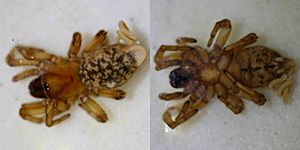Cantuaria borealis facts for kids
Quick facts for kids Cantuaria borealis |
|
|---|---|
| Scientific classification |
The Cantuaria borealis is a special type of trapdoor spider that lives only in New Zealand. These spiders are known for building cool burrows with a "trapdoor" at the entrance!
Contents
About This Spider
Cantuaria borealis spiders are big and strong. They come in many shades of brown, like orange, red, yellow, olive, and even purple! They have eight eyes right in the middle of their head, arranged in two or three rows. These spiders can grow to be between 8 and 33 millimeters long.
Male and female Cantuaria borealis spiders look quite similar when they are young. But after their last skin-shed (called a moult), the males become darker and a bit stockier. Male spiders have a clear palpal organ (a special part used for mating), and females have internal parts for reproduction.
Where They Live
Around the World
Other types of Cantuaria spiders can be found in parts of Africa and Asia. You might find them in places like Madagascar, India, Southeast Asia, and even in South and Central America.
In New Zealand
Cantuaria borealis spiders live all over the South Island of New Zealand. Many are found in the Canterbury Region, the Banks Peninsula, and the West Coast. These spiders don't travel very far. They usually only walk a few meters before digging their own burrow. Because they don't move much, different groups of these spiders often become different species over time.
Their Homes
Cantuaria borealis spiders are "fossorial." This means they spend most of their lives underground. They only come out to find a mate, move to a new spot, or catch food. They dig burrows that are usually 30 to 40 centimeters deep. The deepest burrow ever found was 49 centimeters deep!
Spider Life Cycle
Cantuaria borealis spiders grow slowly and live a long time. Female spiders can live for up to 20 years! They don't lay many eggs each year. A close relative, Cantuaria huttoni, was found to have only 18 to 20 eggs in its egg sac. Baby spiders can't move around on their own until they are about a month old.
The mother spider takes care of her babies for 6 to 18 months. She helps them until they are old enough to dig their own burrows. These spiders often build their burrows close to each other, forming small groups.
Male spiders leave their burrows to find a female mate during the autumn and winter. Female spiders, however, almost never leave their burrows. They live their whole lives underground, making their burrow bigger and longer as they grow.
What They Eat
Cantuaria borealis spiders are carnivores, which means they eat other animals. They mostly eat invertebrates like beetles and snails. They have a clever way to hunt snails! Just before a snail pulls into its shell, the spider quickly bites its soft body. This stops the snail from hiding. After a while, the snail gets tired and can't fight back, and the spider eats it.
Like other spiders, Cantuaria borealis only eats liquid food. When they catch prey, they inject their saliva into it. This saliva has special chemicals (called enzymes) that turn the prey's insides into liquid. Then, the spider sucks up the liquid using its strong abdomen. Any hard parts that can't be digested are either left in the burrow or thrown out of the trapdoor. These spiders only hunt live food. They don't seem interested in dead insects, even if it's something they would normally eat.
New Zealand trapdoor spiders don't use silk trip lines to catch prey. Instead, they feel the vibrations of animals walking near their trapdoor. Spiders have been seen waiting just behind their trapdoor, ready to pounce! Sometimes, a spider might leave its burrow to chase prey, but they usually prefer to stay close to home.
Who Hunts Them
Birds, rodents, and reptiles often hunt Cantuaria borealis spiders. These spiders can also get parasites, like nematodes (tiny worms) and fungi.
One common predator is the Priochemis (Trichocuryus) monachus, which is New Zealand's biggest pompilid wasp. This wasp hunts both young and adult spiders to feed its babies. The wasp will follow the spider until the spider tries to fight. Once the spider attacks, the wasp stings it, making it unable to move. The wasp then drags the spider back to its nest. The wasp's babies eat the spider, saving the important organs for last, which finally kills the spider. Wasps often target these spiders because they are large and can be vulnerable when they are out in the open.
Cantuaria borealis spiders can also be infected by a nematode called Aranimermis gigunteus. This nematode lives inside female Cantuaria borealis spiders. Scientists haven't found these nematodes in male spiders. This is probably because the nematodes need a stable home, which they find inside the female spiders who stay in their burrows for their whole lives (up to 20 years). The nematode also has a long life cycle, which it can't complete in the male spider's shorter lifespan of 1 to 3 years.
Almost all female spiders were found to be infected, and it was common for them to have more than one parasite. If a spider had only one parasite, it was always a female nematode. If a spider had more than two, they were always male nematodes. The most nematodes found in one spider was seven! Interestingly, these Aranimermis gigunteus nematodes can also have their own parasites, which look like tiny cysts.
Helping Farmers
Trapdoor spiders, especially Cantuaria borealis, have been used to help control pests in grasslands. They are very good at catching large invertebrates that can harm crops. Farmers have noticed that fields with trapdoor spiders have fewer problems with grass grubs, which are pests that eat grass roots.
See also
 In Spanish: Cantuaria borealis para niños
In Spanish: Cantuaria borealis para niños


